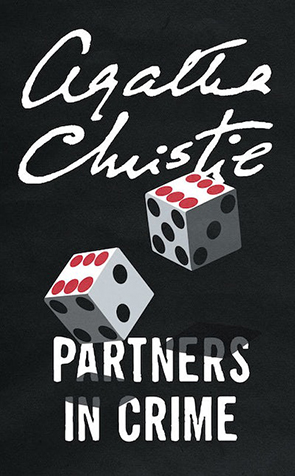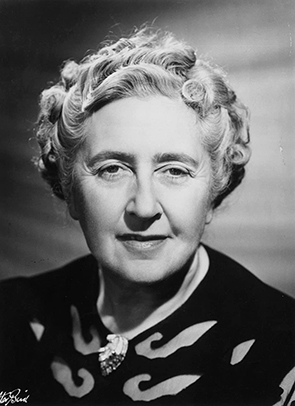Partners in Crime is a collection of short stories with an overarching story behind them. Tommy and Tuppence Beresford are back for their second outing. Six years have passed since their first adventure, The Secret Adversary, a thriller rather than a murder mystery, featuring international intrigue, top secret government papers, a missing girl and a criminal organisation run by a mysterious criminal mastermind. Tommy and Tuppence were married at the end of that book, and Tommy accepted a job in the English secret service. This book opens with Tuppence bored with her life as a comfortably well-off housewife, wishing to return to the adventurous life they previously had. The head of Tommy's agency, Mr Carter, arrives at this point, asking the pair to take on an undercover job. They are to take over the running of a detective agency, Blunt’s International Detective Agency, with Tommy posing as the owner, Mr Theodore Blunt. Blunt is a suspected Russian spy who has been vanished by Scotland Yard. Carter wants Tommy to impersonate Blunt and infiltrate the organisation he works for. Tuppence comes along to enjoy the fun. Between the spy work, they play at being private detectives and take on real cases.
The early cases in this collection are simple enough and Tommy and Tuppence quickly learn the ropes and solve them (or most of them) reasonably efficiently, with only a bit of cheating in their methods. They liven things up by adopting the methods of famous detectives, picking a different detective to emulate in each story. This is part of the fun, picking the references to classic detective stories. Of the fourteen writers identified, I've only read five, so I have a few more authors to add to my Golden Age reading list.
Partners in Crime was a very quick read. It was like fairy floss, something that is enjoyable while experiencing it, but leaving no lasting impression. The stories are not particularly clever or difficult puzzles and are often solved by luck by Tommy and Tuppence rather than investigation or reasoning. But they are amusing, and they work because they add background to the main story of the Russian spies Tommy and Tuppence are really after.
While I may not have thought too highly of the mysteries, what is good about this book, and other books in the Tommy and Tuppence series, is the relationship between the couple. They have no idea about how to run a detective agency but they throw themselves into the role wholeheartedly. They have a huge amount of fun along the way, and manage to somehow catch four murderers, a gang of counterfeiters, a gang of drug smugglers, two jewel thieves and find several missing people. Not too bad a result for complete amateurs! They do have one failure, but even that isn’t too important, as it results in them stumbling into another murder case and redeeming their self-esteem by solving it.
This is not one of my favourite Agatha Christie stories, but it was good fun and worth reading for Christie’s playful use of the methods of characters from other classic mystery stories.
Below is an outline of the stories and their titles to give you a little flavour of the book. However, be warned, there are some spoilers:
A Pot of Tea
Their first case is a missing person case, where a Bertie Wooster-like young man hires the ‘Blunts’ to find a young woman he fancies. The woman has vanished from her home and place of employment, leaving no clues to her whereabouts. Tuppence, in a fit of inspiration, offers him their special 24-hour service, for an additional charge. Tommy is in despair at locating the girl within this time, but Tuppence calmly produces the woman, making tea in their kitchen. It is a setup. The young lady, an old friend of Tuppence’s, despairing of the gentleman ever proposing, conspired with Tuppence to become an object of investigation. So, that is how the first case is ‘solved’, requiring no real detection skills.
The Affair of the Pink Pearl
The second case has a bit more meat to it, when the ‘Blunts’ are called in to catch a jewel thief, hopefully without too much scandal. They get this case solely because the gentleman in the first story recommended them and their amazing 24-hour service. Through sheer luck, Tommy realises who has taken the jewel and unmasks the thief with no scandal at all.
The Adventure of the Sinister Stranger
The third case ties in to the overarching story, with the ‘Blunts’ having their first encounter with foreign spies. They manage to outmanoeuvre the bad guys and arrange for Scotland Yard to vanish a few more people. I did begin to wonder at this point just how all this vanishing of agents was concealed from the Russians, but this point was never addressed. Bad guys are caught, our heroes can go on playing at being detectives.
Finessing the King / The Gentleman Dressed in Newspaper
Many of the cases went over two chapters, but had the same title for both chapters. This fourth case broke that pattern. It’s one of my favourites in the collection. It actually had some clever detective work from Tommy to catch a murderer. The murder takes place at a nightclub that Tommy and Tuppence have visited purely for fun. This isn’t a case they were called in on professionally.
The Case of the Missing Lady
The fifth case was another missing person case, this time a polar explorer, freshly returned from two years at the North Pole several weeks before his expected return. He hires the ‘Blunts’ to find his missing fiancée. He has been told she is travelling with friends, but none of those friends have seen her. He suspects foul play of some kind! The missing lady is eventually found, but the case is not quite a credit to the agency. They do discover her in a nursing home, but rather than being the prisoner of a crazed scientist as they think, she is merely on a crash weight loss program, attempting to slim down before her fiancé’s return.
Blindman’s Buff
With the sixth case we return to the overarching story again, when once again the Russians attempt to find out what is going on inside Blunt’s Detective Agency. Tommy overcomes them again, again mostly due to luck than any skill. This story was pretty simple, but it did have an ingenious booby-trapped floor worthy of any top-notch villain.
The Man in the Mist
The seventh story starts with Tommy and Tuppence consoling themselves in a village pub, having completely failed to solve another jewel robbery at a country house, with the local policeman scoring over them easily. On their way to the railway station though, they stumble on another murder and again Tommy uses some clever thinking to unearth the murderer.
The Crackler
The eighth case has Tommy and Tuppence called in by a policeman they have befriended in the course of their adventures, to go undercover for him in search of a group of counterfeiters. Tommy solves this one, but it seems to be more intuition than by any clever detecting.
The Sunningdale Mystery
The ninth case irritated me somewhat, as Tommy and Tuppence solve yet another murder merely by reading the details in a paper and discussing it over lunch in a cheap café. The police already have someone under arrest, and fairly good evidence against her, but our heroes come up with an alternative theory over lunch. By sheer coincidence, their friendly policeman is, unknown to them, lunching at the next table and overhears their theory and is struck by how undoubtedly correct their deductions are.
The House of Lurking Death
The tenth case is another of the better stories, where the ‘Blunts’ are called in to investigate a case of attempted poisoning, but find the case has turned to murder by the time they arrive at the country house. This one had a rather twisted plot and the solution is rather clever.
The Unbreakable Alibi
The eleventh case features another hapless Bertie Wooster-like character needing the help of the ‘Blunts’ to solve a problem. He has a bet with a young lady that he will not be able to break her alibis, when she produces clear evidence that she was in two different places on the one night. Tuppence has a flash of inspiration and manages to break the alibis.
The Clergyman’s Daughter / The Red House
The twelfth case was the second that had two chapters named differently. It’s another that I really liked, in which Tommy and Tuppence do some clever thinking to solve a haunted house mystery, unmask the villain and find some hidden treasure. Scooby Doo!
The Ambassador’s Boots
The thirteenth case seemed obvious to me from the start, but it takes Tommy and Tuppence a bit of time to solve. It starts as a simple puzzle as to why the US Ambassador’s kitbag was temporarily taken and then replaced, with nothing missing from it. After some convoluted turns, our young heroes unmask a gang of drug smugglers.
The Man Who Was No. 16
The final story in the book wraps up the overarching Russian spy story, with the capture of the master spy. Tommy and Tuppence have a few anxious moments in this case, but ultimately they get their man and retire from the private detective business, celebrating their triumphs.
 RSS Feed
RSS Feed Facebook
Facebook Instagram
Instagram YouTube
YouTube Subscribe to our Newsletter
Subscribe to our Newsletter






No one has commented yet. Be the first!